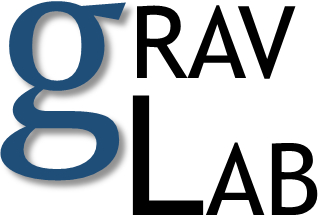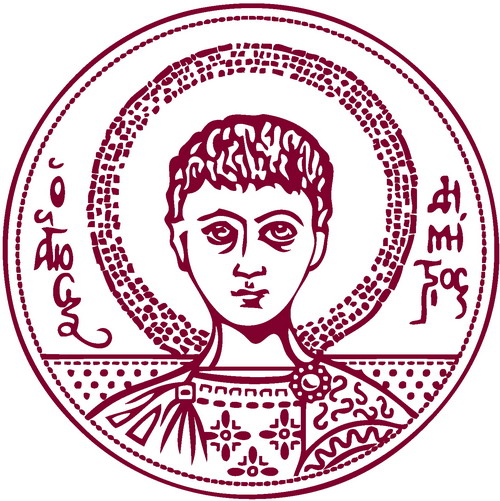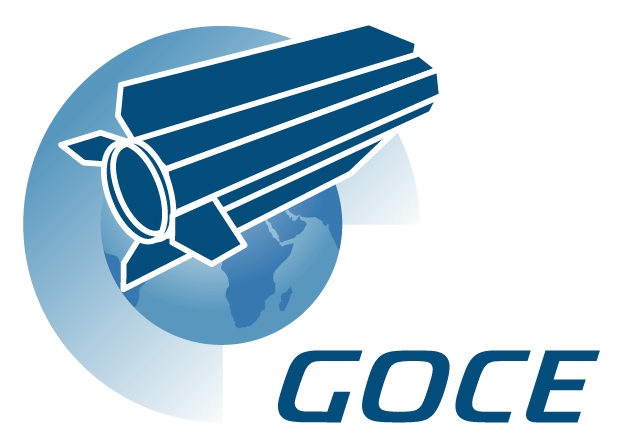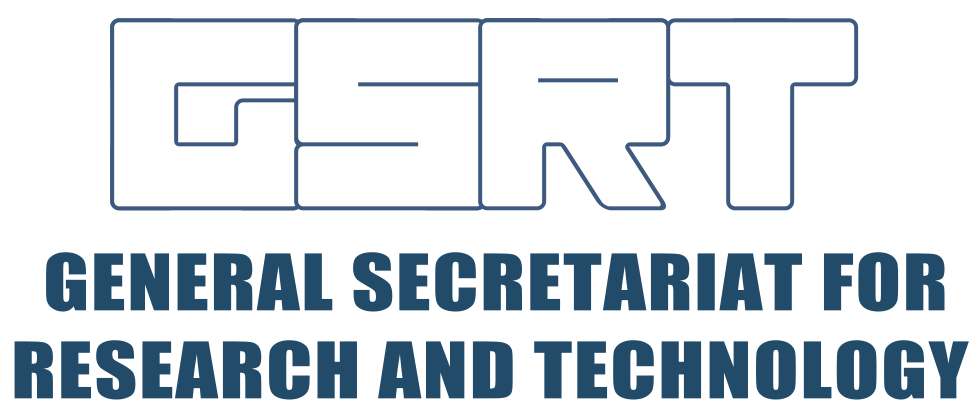GeoGravGOCE at a glance
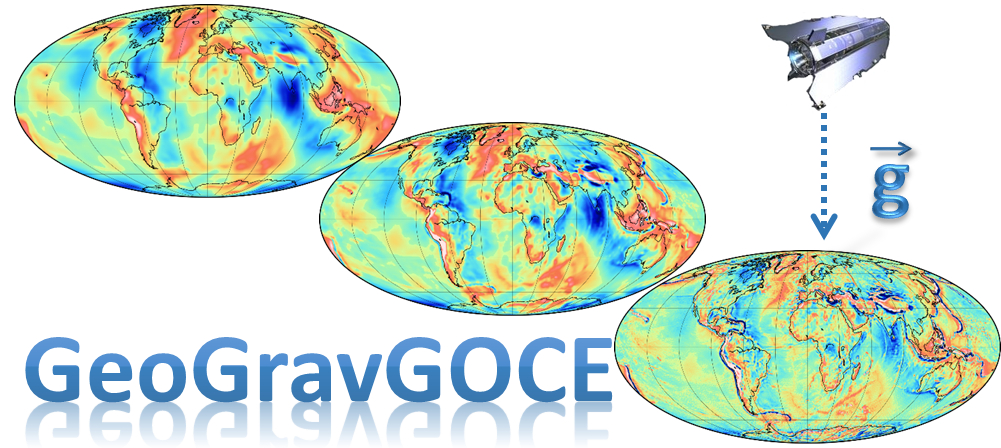 Monitoring the Earth’s
gravity field both over marine and continental regions has been the focus of extensive geodetic research for the past decades, but
has gained increased importance during the last years due to the recent gravity-field dedicated satellite missions. With the missions of CHAMP and GRACE
setting the path, ESA’s GOCE mission has offered breakthrough opportunities for improved insights into the Earth’s gravity field and geoid. Additionally,
the synergistic use of geodetic, oceanographic and earth observation data contributed to other geo-scientific areas as well. The key contribution of the
GOCE mission has been in its unprecedented representation of the Earth’s geoid, hence contributing significantly to the synergy of geodesy with the rest
of the Earth sciences, like geology, geodynamics, hydrology and oceanography. All related studies thus far rely either on the exploitation of GOCE SGG
data in their original Gradiometric Reference Frame at satellite altitude, which after proper processing are provided in the form of spherical harmonics
expansions of the Earth’s potential. This is known in geodesy as spherical harmonic analysis (SHA) and provides to the scientific community harmonic
coefficients derived from GOCE and other satellite and terrestrial data, up to some specific degree of model expansion. The power
of GOCE-based GGMs stems from the fact that the entire processing of GOCE SGG data and the respective filtering is done through the SHA, hence the
provided field and gravity functionals are already processed. The user in that case can apply spherical harmonic synthesis (SHS) of the coefficients,
which is trivial to the geodetic community, to get GOCE-only functionals of the Earth’s potential.
Monitoring the Earth’s
gravity field both over marine and continental regions has been the focus of extensive geodetic research for the past decades, but
has gained increased importance during the last years due to the recent gravity-field dedicated satellite missions. With the missions of CHAMP and GRACE
setting the path, ESA’s GOCE mission has offered breakthrough opportunities for improved insights into the Earth’s gravity field and geoid. Additionally,
the synergistic use of geodetic, oceanographic and earth observation data contributed to other geo-scientific areas as well. The key contribution of the
GOCE mission has been in its unprecedented representation of the Earth’s geoid, hence contributing significantly to the synergy of geodesy with the rest
of the Earth sciences, like geology, geodynamics, hydrology and oceanography. All related studies thus far rely either on the exploitation of GOCE SGG
data in their original Gradiometric Reference Frame at satellite altitude, which after proper processing are provided in the form of spherical harmonics
expansions of the Earth’s potential. This is known in geodesy as spherical harmonic analysis (SHA) and provides to the scientific community harmonic
coefficients derived from GOCE and other satellite and terrestrial data, up to some specific degree of model expansion. The power
of GOCE-based GGMs stems from the fact that the entire processing of GOCE SGG data and the respective filtering is done through the SHA, hence the
provided field and gravity functionals are already processed. The user in that case can apply spherical harmonic synthesis (SHS) of the coefficients,
which is trivial to the geodetic community, to get GOCE-only functionals of the Earth’s potential.
The other possibility attempted in the literature so far, refers to the preparation of GOCE SGG grids at some very high altitude (around 250 km), where the
respective processing is done by Least Squares Collocation (LSC). In this latter case, the filtering performed to the
inherently noisy SGG data is performed with classic spatial and digital filters. In both of the aforementioned approaches, only the vertical gradients Vzz of
the potential measured by the satellite are used, while their final product is over-smoothed without attention to local details depicted in the raw satellite
data. This is normal, as both GGMs and grids at a specific altitude are dedicated for global use, i.e., they provide an optimal, in terms of gravity field
representation, picture of the Earth’s potential for the entire globe.
Within GeoGravGOCE, we propose a completely new approach, where the irregular GOCE gradients are used and referred to some mean earth sphere for further processing. This first step will be done employing the original Level1b products, hence the raw scatter observations without any gridding. The latter is to be avoided in order to reduce the impact of correlated errors in the GOCE observations. All SGG derivatives will be used exploiting the full spectrum of the GOCE measurements, hence not limiting ourselves to the vertical potential gradients only. This is crucial in terms of the novelty of our approach, as the derivatives along the xx and yy axes are of the same accuracy as the vertical ones and can show variations of the Earth’s potential due to lateral density variations.
Moreover, within GeoGravGOCE, the filtering of the gradients will not be carried out only with classical spatial and digital filters, but employing wavelet multi-resolution analysis (WL MRA). While classical filters cannot distinguish between space and time features, as well as specific details with geophysical meaning in the three-dimensional space, WL MRA allows for selective filtering in both space and time and of some and not all coefficients. Another novel aspect is that GeoGravGOCE will attempt for the first time the downward continuation of GOCE filtered SGG data to the Earth’s surface and the geoid, while their combination with in-situ data will be performed at that space and not at some high altitude. Hence, attenuation of the GOCE contribution with height will be kept to a minimum, while full exploitation of the satellite signal will be achieved. Finally, within the proposed project, we will attempt for the first time the combination of GOCE SGG data with terrestrial ones, without any need to make assumptions for the upward continuation to satellite altitude, so as to exploit the full signal power of GOCE observables. To carry this operation out, we will rely on the power spectrum of the existing local gravity data, so as to replicate the expected covariance structure of the gradiometric observations.
The aforementioned set the main aim of the GeoGravGOCE project, which is related to the exploitation of GOCE SGG data towards gravity field and geoid determination at regional scales with a focus on the prossible improvements at the shorter wavelengths of the gravity field spectrum. The main objectives of the project are:
- validate the spectral behavior of the entire record of GOCE SGG data in terms of their signal and error PSD and assess their accuracy with upward continued local free-air gravity anomaly data sets,
- develop a GUI for the automatic transformation of GOCE gradients from the GRF to the LNOF and novel filtering algorithms for the rigorous filtering of GOCE SGG data to the GOCE MWB
- model the Earth’s gravity field in terms of geoid model development, with high-accuracy, for the wider Greek territory with the use of GOCE data.
The first objective is to validate the spectral behavior of the entire record of GOCE SGG data in terms of their signal and error PSD and assess their accuracy with upward continued local
free-air gravity anomaly data sets. In order to perform this combination scheme, first an initial pre-processing of the GOCE SGG data will be carried out. It is known that GOCE
measures two gradients, namely 𝑉𝑥𝑦 and 𝑉𝑦𝑧, with 10 times lower accuracy than the rest, therefore all pre-processing will be carried out in the GRF so that the errors of the
these gradients will not be propagated to the rest. Additionally, the ESA-released official Level 2 GOCE products from the current baseline (generated from EGG_NOM_1b reprocessed
with v5.06 processor and the latest v7.00 processor) will be used and refer to the SGG products (EGG_NOM), Kinematic Orbit files (SST_PKI), Rotation Matrix Files (SST_PRM) and GPS
times from the SST_PSO header.
The entire GOCE SGG database spanning between 01.11.2009 to 20.10.2013 will be used, i.e., excluding only the de-orbiting phase. During the data pre-processing, gradients of the normal
potential 𝑉'ij will be determined at the GOCE observation points and at satellite altitude in the LNOF using the GRS80 as a normal field and evaluating the first fourteen zonal
coefficients. Then these gradients will be transformed from the LNOF to the GRF following the sequence of the transformation from the LNOF to the EFRF, then form the EFRF to the
IRF and then form the IRF to the GRF.
The second objective is to develop a GUI for the automatic transformation of GOCE gradients from the GRF to the LNOF and novel filtering algorithms for the rigorous filtering of GOCE SGG data to the GOCE MWB. Alongside, a novel methodology based on Monte Carlo simulated annealing and system theory will be developed in order to first downward continue GOCE gradients to a mean orbit and then to a mean Earth sphere. This will be based on an iterative approach during which XGM2017a will server as the ground truth potential information.
The third objective is to model the Earth’s gravity field in terms of geoid model development, with high-accuracy, for the wider Greek territory with the use of GOCE data. Having the filtered GOCE gradients at the same level as the gravity observations, various collocation geoid solutions will be estimated. Their assessment will be performed against GNSS/Leveling data for the Hellenic region.
